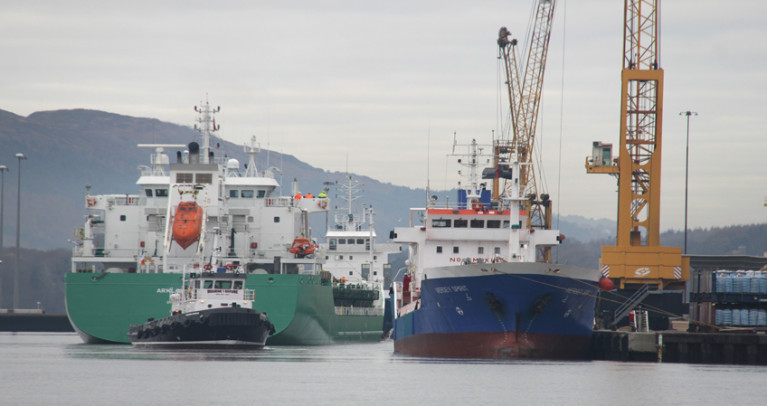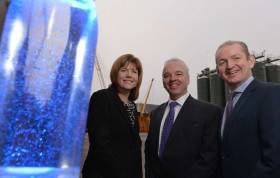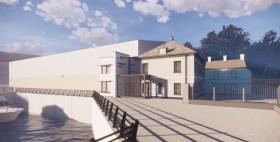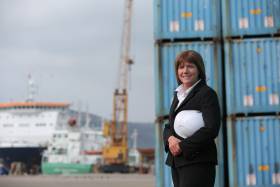Displaying items by tag: Warrenpoint Port
Students Visit Seatruck/CLdN Freight-Ferry at Warrenpoint Port
Warrenpoint Harbour Authority this week welcomed students from St. Louis Grammar School in Kilkeel, Co. Down as they took a tour of the port estate before boarding a Seatruck Ferries-freight ship that operates on the Irish Sea.
The young students boarded the M.V. Seatruck Point, Afloat adds a P-class ro-ro vessel custom built for Seatruck Ferries but was originally named Clipper Point. The 210 trailer-unit capacity vessel is the leadship of a quartet built by Astilleros de Huelva S.A., Huelva in southern Spain.
WHA thanked the Seatruck team for supporting the visit and showing the students around the 14,759 gross tonnes freight-ferry which operates the Warrenpoint-Heysham route.
This route is one of three on the Irish Sea that Seatruck (owned by CLdN) operates between the UK and Ireland where at Dublin Port, hub operations are linked to routes connecting mainland Europe including the Iberian Peninsula.
The port authority has a close association with the school as former St Louis student and deputy Harbour Engineer at WHA, James Cunningham gave a presentation about Warrenpoint Port.
Micheal White, (son of WHA’s Mechanical Supervisor Raymond and) teacher at St Louis, organised the visit to the port on Carlingford Lough.
Warrenpoint Port held for the first time an annual general meeting (AGM) virtually due to the unprecedented circumstances brought by the COVID-19 pandemic and current Government guidance on social distancing.
A digital copy of the Co. Down's port Annual Report, outlining the performance of the Harbour in 2019 can be viewed and downloaded here
The report according to Warrenpoint Port confirms their position as the second largest harbour in Northern Ireland with tonnage of 3.5 million tonnes as we recorded turnover of £6 million.
While the coronavirus continues to impact locally and across the globe, Warrenpoint Port has remained open throughout the lockdown, as we have worked with our customers to fulfil our important role helping to ensure the local economy and food supply chains have continued to flow.
There was significant progress made throughout 2019 in efforts to optimise the harbour estate as we continued to invest in the reconfiguration of the port while work on the restoration and refurbishment of our landmark Town Dock House was completed in October re-establishing a direct interface between the harbour office and the town itself.
As it was impossible to hold our AGM in public, members of our community were invited to submit questions in advance of the meeting (held last Tuesday) for consideration.
There was a huge response from our community, and we are pleased to provide answers to these questions below.
Due to the volume of questions received, particularly in regards to the development by Nippon Gases of a liquid CO2 hub to service the Irish food and drinks market, some questions have been summarised in order to provide as full and concise answers as possible.
Individual responses will follow by email by the end of the week.
AGM Questions and Answers here
In reflecting on the ongoing public health crisis, Warrenpoint Port CEO David Holmes has issued a statement.
“As the second largest port in Northern Ireland, we play a major role as a catalyst for economic growth across the region and the island as a whole.
“That role has rarely been as important than at present as the world grapples with the COVID-19 pandemic.
“We are committed to promoting the highest levels of health and safety for our staff and their families, customers, and community while also serving the needs of local businesses that rely on us to facilitate the efficient transit of goods, including many of the essential items so vital to wider society at this time.
“In order to ensure port services continue to operate as normal, we are practicing social distancing throughout the harbour estate while staff have changed their working patterns to ensure fewer are on site at any one time.
“We recognise and appreciate the efforts of all port employees for their assistance and commitment to helping us achieve this.
“Additionally, we have increased the provision of hand sanitisation products across the port and introduced other measures that will limit the risk to employees and other harbour users.
“We are mindful that all of us have a duty to contribute to the fight against coronavirus and are pleased to play our part in keeping Northern Ireland and the island as a whole moving in the weeks and months ahead.”
Warrenpoint Port CEO Comments Following Visit by Michael Gove
Northern Ireland's Warrenpoint Port CEO Clare Guinness, following a visit to the port by The Chancellor of the Duchy of Lancaster Michael Gove issued the following statement:
“We facilitated a visit to the port by Michael Gove.
“During a robust exchange of views, we pressed home to the minister the concerns not just of the port, but of the wider business community of the dangers posed by a ‘no deal’ Brexit.
“Situated close to the border between the UK and the Republic of Ireland, Warrenpoint Port handled 3.6 billion tonnes of cargo in 2018 valued at more than £6.5 billion, around 40 per cent of which either originated from or was destined for the Republic of Ireland.
“As a key driver for economic growth locally, we consider it vital for the prosperity of the entire Northern Ireland economy that that trade is able to continue to flow and grow.
“That requires a border that is frictionless and for us that means no barrier either on the island of Ireland or in the Irish Sea so that our economy can continue to enjoy the open trade we have done for many years.
“We are yet to receive assurances that any of this is possible under a ‘no deal’.”
Warrenpoint Port Appoints New CEO David Holmes
Warrenpoint Port has appointed David Holmes as its new Chief Executive Officer.
David joins the harbour, the second largest in Northern Ireland, from Irwin’s Bakery where he has been Operations Director for the past six years.
Previously, David has held senior positions at Kerry Group, Unigate, and Premier Foods.
Stan McIlvenny, Chairman of Warrenpoint Harbour Authority, said:
“We are delighted to announce the appointment of David Holmes as new Chief Executive Officer of Warrenpoint Port.
“With a background dealing with complex operations and supply chains in the food industry, David’s wealth of experience will be a tremendous asset to the harbour.
“The board looks forward to working with David as he continues the transformative body of work that has been taking place at the port over recent months and years as we continue to see tonnage and turnover increase annually.
"On behalf of the board of Warrenpoint Harbour Authority, I also wish to thank our outgoing CEO Clare Guinness (appointed in 2017) for her great contribution to the port and the economic prosperity of the wider region during her tenure."
David will take up the post in late summer.
Warrenpoint Port Makes £800,000 Plant Investment
Warrenpoint Port has made an investment of £800,000 in new plant that will significantly improve efficiency at Northern Ireland’s second largest harbour.
Authorities at the port have taken delivery of the first wave of the new fleet which will include seven forklift trucks.
Eoin O’Mahony, Head of Engineering and Estates, Warrenpoint Port said: “This investment in new plant is just the latest step in our drive to maximise efficiency across all our operations and it is a great pleasure to accept the first tranche of the new consignment that will be fully complete by September.
“The new forklifts will have a broad range of lifting capabilities allowing us to handle the full spectrum of commodities that pass through the port from timber, to steel and beyond.”
The new forklifts, manufactured by Hyster, have lifting capacities ranging from 5 to 16 tonnes, while the harbour has also taken delivery of a new Bobcat loader.
The investment follows the purchase of a new crane in 2018 while two further cranes have also been refurbished in recent months.
Ian Taylor, Operations Manager, Warrenpoint Port, added:
“The amount of goods passing through Warrenpoint is growing year-on-year and we expect that trend to continue.
“Continually reviewing our operational requirements and investing in new plant and equipment when needed ensures that we maintain the high quality of service that our customers expect, providing for a cost-effective and expeditious transit of goods through the harbour.”
Warrenpoint Port handed a record 3.6 million tonnes of cargo in 2018, valued at £6.5 billion.
Last year, harbour authorities unveiled a 25-year masterplan that forecast a significant increase in trade over the coming decades including a rise by up to 80% of core roll on, roll off freight by 2040.
Japanese industrial gas company Nippon Gases is to establish a major liquid carbon dioxide (CO2) import and distribution terminal at Warrenpoint Port.
The €11 million (£9.5m) project represents the first major investment in Ireland by the firm since it purchased Praxair Gases Europe in December ‘18.
The facility which will store liquid CO2 for the food and drinks industry across Ireland aims to significantly improve the security of supply for the gas on both sides of the border, and also lead to a major reduction in carbon emissions by minimising the need for road tankers.
Work is due to commence this summer on the construction of the facility, which is expected to become operational in Q2 2020.
Clare Guinness, CEO, Warrenpoint Port, commented:
“This investment by Nippon Gases is a major endorsement of Warrenpoint Port and recognises the benefits provided by our unique position equidistant between Belfast and Dublin that ideally places the harbour to facilitate the distribution of goods across the whole of Ireland.
“The commencement of construction work on the terminal soon will signal the final stage of a scheme that we have been working on for some time.
“The project represents another important element in our efforts to enhance Warrenpoint Port’s offering and cement our position as a catalyst for economic growth in the local region and further afield.”
The establishment of the liquid carbon dioxide import terminal, which will have the capacity to hold approximately 2,500 tonnes, follows a major shortage of the gas experienced in Ireland and the United Kingdom during the summer of 2018.
Gerard Dore, Commercial Manager, Nippon Gases, added:
“CO2 is a key ingredient in the production of food and beverages. People know that it adds the fizz to drinks. Many are not aware however that it is also used in the processing of meat and food products. Food applications include modified atmosphere packing, chilling and freezing of foods. It is also used in the production of dry ice which is used in airline catering, online food sales plus transport of pharmaceutical and clinical products.
“However, with no significant native source of liquid Carbon Dioxide on the island of Ireland. All liquid carbon dioxide is currently imported by all the industrial gas companies daily into Ireland via road tankers coming across the Irish Sea.
“Nippon Gases already own a number of CO2 terminals and ships in North West Europe. With this investment in Ireland, Nippon is changing the supply chain radically for their Irish customers by importing via ship rather than road tanker. It is worth noting that one ship will be the equivalent of 90 road tankers coming across the Irish Sea. The carbon footprint reduction is very large. In addition, we are also linking in with the more abundant CO2 source region of continental Europe, namely the Netherlands. This is important as the British Isles currently do not produce sufficient quantities of CO2 for their annual usage.
“This facility will ensure we can continue to guarantee into the future food grade, completely traceable liquid Carbon Dioxide that Irish industry both North and South of the border desires.
“We are delighted to be working with Warrenpoint Port on this exciting venture and look forward to commissioning the terminal next year.”
The works are in addition to Warrenpoint Port’s £4m capital investment programme that includes a reconfiguration of internal infrastructure and the regeneration of the landmark Town Dock House building that will re-establish an interface between the harbour and the town.
Warrenpoint Port Starts £4m Investment Programme
Work has commenced on the redevelopment of the landmark Town Dock House at Warrenpoint Port, the flagship project in the harbour’s £4 million capital investment programme.
The building, which fronts onto Warrenpoint Town Square, will be returned to its former use as the main harbour office, re-establishing a direct interface between the port and the town centre.
Clare Guinness, CEO, Warrenpoint Port, said: “As a key local employer, Warrenpoint Port has long-established historic links with our town and the surrounding area.
“The redevelopment of Town Dock House, an iconic building at the heart of our town centre, will build on those links and provide a major regeneration boost that we can all enjoy.
“The relocation of the administrative offices is just the first phase of our plans for the Town Dock, however. We also look forward to progressing plans to open up the dock to the public by creating new openings in the wall and railings to allow access from the Town Square to the water’s edge at the marina.”
The Town Dock House works will include a complete refurbishment of the existing building and an extension which will provide additional office space and board room facilities.
Eamon Larkin, Director of Newry-based architecture Milligan Reside Larkin which designed the scheme, added:
“Our team worked with Warrenpoint Port to sensitively design an extension to the former office building without impinging on the status of the existing building.
“It is an exciting project to be involved in as it will add to the vitality of Warrenpoint Town centre and complement other recent developments in the area.”
The project is part of a £4m capital investment programme that also includes the reconfiguration of internal port infrastructure, a new road layout, and additional plant and equipment.
Clare added: “Demand for our services is growing year-on-year. By continuing to invest in our facilities, we can ensure the Port is best placed to capitalise on that growing demand for the benefit of port users, our customers, our community and the wider economy.”
Building work on Town Dock House will be carried out by Newry-based firm Killowen Contracts and is expected to take six months to complete.
Warrenpoint Port Records Highest Tonnage in Its History
Warrenpoint Port handled 3.6 million tonnes of cargo in 2018, the highest annual level recorded in the harbour’s history.
The total value of goods moving through the port also reached record levels, surpassing £6.5 billion for the first time.
The trading figures confirmed Warrenpoint’s position as the second largest port in Northern Ireland as it handled 12 per cent of all seaborne trade in the region.
Clare Guinness, CEO, Warrenpoint Port, commented:
“2018 was another record year for Warrenpoint Port following four successive years of growth.
“Much of the increase can be attributed to the success of our core roll-on roll-off freight service while we have also diversified the range of bulk goods that we handle as we look towards further growth in 2019 and beyond.”
The port handles a range of goods including timber, steel, animal feed, and cement and deals with imports to and exports from countries and regions across the world including Spain, Italy, Sweden, Belgium, Germany, Ukraine, and the Americas.
The overall number of units that passed through the port in 2018 rose to more than 126,000, boosted by a 4.8 per cent increase in freight units.
This followed the deployment by Seatruck Ferries of two larger freight vessels on the key Warrenpoint to Heysham route in direct response to growing demand for unaccompanied trailer space.
The move will enable the operator to carry 30,000 additional trailers annually on the crossing as it forecasts continued growth in the service beyond Brexit.
The port also made several major investments during the year including more than £3m on the purchase of a new crane and the refurbishment of two others.
Clare added:
“As we look towards further growth in 2019 and beyond, we have plans to continue our investment programme over the coming months as we aim to improve port infrastructure, plant and equipment.
“This will allow us to be more flexible, more efficient and open up more space, enabling trade to grow in line with expectations and widen the scope of goods we can handle.
“Last year saw the commencement of wood chip exports from Warrenpoint for the first time while we also handled our largest consignment of wind turbines.”
The rising levels of activity resulted in the number of staff directly employed by the port increasing to 70.
More than 200 people work at the harbour every day while port activity sustains more than 1,500 jobs locally.
Clare added:
“Warrenpoint Port exists for the benefit of our economy and community. Trade is the lifeblood of the economy and the port activities support thousands of jobs which are vital for the prosperity of the region.
“As a trust port, we are committed to continually invest in the port estate and our community as we seek to build on and sustain our position as a driver for growth for many years to come.”
Warrenpoint Port's New £3m Crane Enters Service
Warrenpoint Port has commissioned a new crane and has commenced the refurbishment of two other cranes following a major £3 million capital investment.
The new crane, built and supplied by Finnish manufacturer Konecranes, will significantly improve efficiency at the Port by reducing loading and unloading times, with the ability to lift 100 tonnes up to 42 metres above sea level.
Clare Guinness, CEO at Warrenpoint Port, said: “After much anticipation, we are proud to announce that works have reached completion on the build of our latest crane, which is now fully operational.
“The £3 million investment forms part of a major drive to facilitate our 25-year growth plan that was announced earlier this year.”
In 2017, Warrenpoint Port, Northern Ireland’s second largest port, handled a record 3.56 million tonnes of cargo valued at £6.2 billion.
The crane investment will improve the Port’s bulk business, which includes grain, timber, steel, wood chip, coal and cement.
Clare continued: “This investment in our operational equipment marks the start of a considerable port-wide capital expenditure programme to improve efficiency, customer service and throughput. This will help us obtain our strategic objective which is to boost prosperity in the region given our position as a major catalyst for economic growth.”
Founded more than 80 years ago, Konecranes is one of the world’s leading makers of heavy lifting equipment serving the manufacturing and processing industries, shipyards, ports and terminals.
Neil Griffiths, Regional Sales & Service Director, Konecranes Port Solutions, added: “We are very proud to have Warrenpoint, who has gradually invested in Konecranes Gottwald mobile harbour cranes, as our partner in cargo handling. The most recent addition of the eco-efficient Model 3 crane for handling all kind of cargo increases our long-term customer’s fleet to six cranes and will significantly bolster up Warrenpoint’s position in Ireland.”






































































